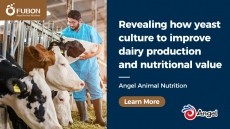Reports from IPPE
Enzyme, phytase combo supports poultry production with less phosphorus: study

The Calgary-headquartered company presented research on the influence of phytase and multi-carbohydrase enzymes in poultry feed with limited phosphorus at the International Packaging and Processing Expo (IPPE) in Atlanta earlier this month.
Rob Patterson, technical director with Canadian Bio-Systems, told us more.
The research found that diets with reduced levels of phosphorus could support or improve chicken weight gain and feed conversion ratio (FCR) when phytase or phytase and multi-carbohydrase enzymes were added to the diet, he said. “What we found was that we increased the phytase, and we saw a nice linear improvement in bodyweight gain and feed efficiency,” he added.
In addition to poultry research, the company has been working on expansion efforts into ruminant nutrition and growing the company’s presence in North America and in parts of Asia, he said.
Phosphorus research
There is not a phosphorus quota in Canada the way there is in other countries, like the Netherlands, but it is an area that has been getting more attention and the topic has the potential to be another social issue, said Patterson.
FeedNavigator is running a free online webinar on poultry gut health on Thursday 2 March 2017. Register now to hear insights from US and European experts.
In the phosphorus reduction feeding trial, the company fed eight trial diets to 640 broilers for 35 days.
The feeds examined included a positive control, or standard poultry diet, that diet with additive phosphorus reduced by 15%, the reduced diet with 500, 1,000 or 1,500 ftu/kg phytase and the phosphorus-limited diet with both multiple levels of the phytase and a multi-enzyme product, Superzyme-CS, the company said. The phytase used was a commercially available product, Bio-Phytase.
“What we found is that when you increased the dose [of phytase] we saw a nice response in terms of performance,” said Patterson. Usually, when phosphorus levels are reduced there is a drop in performance, he added.
Bird measurements were taken on days 7, 21 and 35, the company said. Bird weight gain was improved from days 0-21 for the diets with 1,500 ftu/kg phytase or all three phytase levels with the multi-carbohydrase enzymes.
On day 35, birds getting the 1,000 or 1,500 ftu/kg phytase diets had improved bodyweight gain compared to either control group, the company said. Birds getting any of the phytase fortified diets had improved feed conversion compared to the control diets.
The best bodyweight and bodyweight gains were for birds getting the diet with 1,500 ftu/kg phytase and Superzyme-CS, the company reported. And, the feed additives were found to improve FCR when compared to the control diets.
“We added fiber degrading technology, our multi-carbohydrase, to that [phytase additive] and we saw a stepwise improvement,” said Patterson.
Ruminant nutrition
The Canadian company also is working to demonstrate that it can play a role in ruminant nutrition, said Patterson. Research to demonstrate the effectiveness of its products in ruminant production is ongoing.
“We know a lot about enzymes, a lot about feed compositions and we’re going to transfer that to the ruminant side,” he said. “We know a lot about natural growth products from our modeling on swine and poultry, and that transfers really nicely to the calf.”
It has focused initial expansion, especially on the ruminant side, on brand recognition within North America, he said. However, it also is looking at expanding its presence in markets including Myanmar, Vietnam, the Philippians, Thailand, and Taiwan with a longer view toward efforts with Indonesia, China and Japan.
Source: IPPE abstracts
Title: Effects of combination of phytase and Multi-Carbohydrase enzymes on growth performance and bone mineralization in broilers
Authors: J. Wang, R. Patterson, W. Kyun Kim















